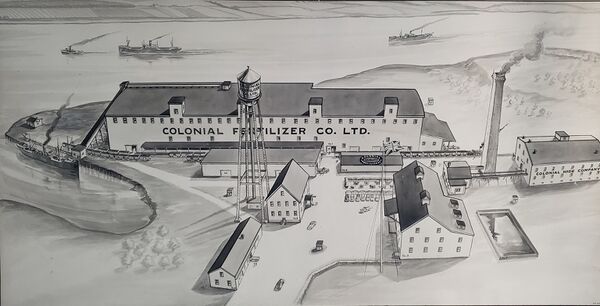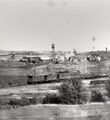Dominion Atlantic Railway Digital Preservation Initiative - Wiki
Use of this site is subject to our Terms & Conditions.
Difference between revisions of "Colonial Fertilizer"
Dan Conlin (talk | contribs) (→Gallery: image) |
Dan Conlin (talk | contribs) (image) |
||
| Line 1: | Line 1: | ||
==Colonial Fertilizer Company, [[Windsor]]== | ==Colonial Fertilizer Company, [[Windsor]]== | ||
| + | [[File:ColonialFertilizer.jpg|right|thumb|600px|Advertising Engraving of the [[Colonial Fertilizer|Colonial Fertilizer Plant]], circa 1950.]] | ||
* Nesbitt Street, [[Windsor]], east of the [[Windsor Wear]] textile plant | * Nesbitt Street, [[Windsor]], east of the [[Windsor Wear]] textile plant | ||
* Mile 0.65 2345-foot long spur from the [[:Category:Subdivision Truro|Truro Subdivision]] | * Mile 0.65 2345-foot long spur from the [[:Category:Subdivision Truro|Truro Subdivision]] | ||
===History=== | ===History=== | ||
| − | The plant began in 1885 with Robert Pigeon and Nicholas Mosher producing “Eureka” brand fertilizer. Mosher died in 1887 and the firm continued as the Pigeon Fertilizer Company. The plan was bought in 1912 by the Consolidate Rendering Company of Boston (later known as Corenco). They changed the name to the Colonial Fertilizer Company and expanded the plant, adding a hide business, the Colonial Hide Company.<ref>Gwendolyn Vaughan Shand, ‘’Historic Hants Country’’, (1979), pages 156 and [[Gary W. Ness]], ''[[The Dominion Atlantic Railway: 1894-1994]]'', (2014), page 86.</ref> The company came to encompass a large complex of sheds and warehouses built around a wharf on the St. Croix River, which included a 2345-foot long spur from Mile .65 on the DAR’s Midland branch which served a long loading bay from the main plant building and continued to a double track spur on the Colonial Fertilizer wharf. | + | The plant in [[Windsor]] began in 1885 with Robert Pigeon and Nicholas Mosher producing “Eureka” brand fertilizer. Mosher died in 1887 and the firm continued as the Pigeon Fertilizer Company. The plan was bought in 1912 by the Consolidate Rendering Company of Boston (later known as Corenco). They changed the name to the Colonial Fertilizer Company and expanded the plant, adding a hide business, the Colonial Hide Company.<ref>Gwendolyn Vaughan Shand, ‘’Historic Hants Country’’, (1979), pages 156 and [[Gary W. Ness]], ''[[The Dominion Atlantic Railway: 1894-1994]]'', (2014), page 86.</ref> The company came to encompass a large complex of sheds and warehouses built around a wharf on the St. Croix River, which included a 2345-foot long spur from Mile .65 on the DAR’s Midland branch which served a long loading bay from the main plant building and continued to a double track spur on the Colonial Fertilizer wharf. |
The plant generated large amounts of seasonal railway traffic which peaked in the fertilizer season from March to May.<ref>George Bishop, ”Railway Notes”, [[:Category:The Advertiser|The Advertiser|’’The Advertiser’’]] Feb. 18, 1937, May 26, 1938</ref> Large shipments sometimes required the daily assistance of an extra switcher engine sent from [[Kentville]].<ref>[[Gary W. Ness]], ''[[The Dominion Atlantic Railway: 1894-1994]]'', (2014), page 86 and George Bishop, ”Railway Notes”, [[:Category:The Advertiser|''The Advertiser'']] May 6, 1937</ref> as well as special fertilizer trains to [[Windsor]] and [[Digby]] <ref>George Bishop, ”Railway Notes”, [[:Category:The Advertiser|''The Advertiser'']] May 12, 1938</ref> and extra trips of the [[SS Princess Helene]] taking fertilizer to New Brunswick and Maine customers.<ref>George Bishop, ”Railway Notes”, [[:Category:The Advertiser|''The Advertiser'']] , May 6, 1937</ref> Fertilizer shipments by ship continued into the 1960s. | The plant generated large amounts of seasonal railway traffic which peaked in the fertilizer season from March to May.<ref>George Bishop, ”Railway Notes”, [[:Category:The Advertiser|The Advertiser|’’The Advertiser’’]] Feb. 18, 1937, May 26, 1938</ref> Large shipments sometimes required the daily assistance of an extra switcher engine sent from [[Kentville]].<ref>[[Gary W. Ness]], ''[[The Dominion Atlantic Railway: 1894-1994]]'', (2014), page 86 and George Bishop, ”Railway Notes”, [[:Category:The Advertiser|''The Advertiser'']] May 6, 1937</ref> as well as special fertilizer trains to [[Windsor]] and [[Digby]] <ref>George Bishop, ”Railway Notes”, [[:Category:The Advertiser|''The Advertiser'']] May 12, 1938</ref> and extra trips of the [[SS Princess Helene]] taking fertilizer to New Brunswick and Maine customers.<ref>George Bishop, ”Railway Notes”, [[:Category:The Advertiser|''The Advertiser'']] , May 6, 1937</ref> Fertilizer shipments by ship continued into the 1960s. | ||
Revision as of 20:54, 23 March 2024
Colonial Fertilizer Company, Windsor

- Nesbitt Street, Windsor, east of the Windsor Wear textile plant
- Mile 0.65 2345-foot long spur from the Truro Subdivision
History
The plant in Windsor began in 1885 with Robert Pigeon and Nicholas Mosher producing “Eureka” brand fertilizer. Mosher died in 1887 and the firm continued as the Pigeon Fertilizer Company. The plan was bought in 1912 by the Consolidate Rendering Company of Boston (later known as Corenco). They changed the name to the Colonial Fertilizer Company and expanded the plant, adding a hide business, the Colonial Hide Company.[1] The company came to encompass a large complex of sheds and warehouses built around a wharf on the St. Croix River, which included a 2345-foot long spur from Mile .65 on the DAR’s Midland branch which served a long loading bay from the main plant building and continued to a double track spur on the Colonial Fertilizer wharf.
The plant generated large amounts of seasonal railway traffic which peaked in the fertilizer season from March to May.[2] Large shipments sometimes required the daily assistance of an extra switcher engine sent from Kentville.[3] as well as special fertilizer trains to Windsor and Digby [4] and extra trips of the SS Princess Helene taking fertilizer to New Brunswick and Maine customers.[5] Fertilizer shipments by ship continued into the 1960s.
The company was sold to Canada Packers in 1960 which also owned the Shur-Gain feed and fertilizer operation in Port Williams. In the 1970s, operations at the Windsor Plant were transferred to the Port Williams plant and Colonial Fertilizer closed. [6] Little trace remains of the plant today, although the overgrown route of the spur line may still be followed from old Midland roadbed to the silted up dock area just north of the Midland roadbed.
Gallery
DAR locomotive No. 556 watering at the Windsor Water Tower with the Windsor Wear textile factory and the Colonial Fertilizer Plant, circa 1920s.
Windsor tracks with Colonial Fertilizer plant in background and a MOW cars No. 859 and No. 872 on siding of the Midland/Truro Subdivision, circa mid 1930s.
Engraving showing an artists impression of the Colonial Fertilizer and Colonial Hides Plants, circa 1950.
Survey plan of Halifax Subdivision tracks, structures, and right-of-way through Windsor, including details of the Colonial Fertilizer plant structures and tracks, January 1955.
References and Footnotes
- ↑ Gwendolyn Vaughan Shand, ‘’Historic Hants Country’’, (1979), pages 156 and Gary W. Ness, The Dominion Atlantic Railway: 1894-1994, (2014), page 86.
- ↑ George Bishop, ”Railway Notes”, The Advertiser|’’The Advertiser’’ Feb. 18, 1937, May 26, 1938
- ↑ Gary W. Ness, The Dominion Atlantic Railway: 1894-1994, (2014), page 86 and George Bishop, ”Railway Notes”, The Advertiser May 6, 1937
- ↑ George Bishop, ”Railway Notes”, The Advertiser May 12, 1938
- ↑ George Bishop, ”Railway Notes”, The Advertiser , May 6, 1937
- ↑ Gwendolyn Vaughan Shand, ‘’Historic Hants Country’’, (1979) pages 157.


